 When it comes to fashion she doesn't clown around. 
 Is there such a thing as too many dots? French actress Leslie Caron tests the limits in the beachy 1965 promo photo at top. A polkadot bikini, we can all probably agree, is cute. But a polkadot bikini with a floppy polkadot hat? Is she possibly violating the dot density rule where the oh so fragile line into clown territory is crossed? Is there such a thing as too many dots? French actress Leslie Caron tests the limits in the beachy 1965 promo photo at top. A polkadot bikini, we can all probably agree, is cute. But a polkadot bikini with a floppy polkadot hat? Is she possibly violating the dot density rule where the oh so fragile line into clown territory is crossed?
Not that we're fashion gurus, but we think this hat is definitely too garish to look good on most women, at least outside of the Belmont Stakes. Admit it—if your wife, girlfriend or friend were to wear it on the beach you'd be hoping a gust of wind would rip it off her head and carry it into the ocean to be eaten by a moray eel. But on Caron? There's no dotted line to cross—she actually makes this look nice, which is what movie stars do. You'll also notice this appears to be the world's most versatile hat, because she not only goes for a dip in it, but later pairs it with a high-necked, sleeveless polkadot top—another item you'd be hoping would end up in the ocean if a woman you knew wore it. Well, that's fashion—a thing the Carons of the world can wear and hungry eels don't even come to mind. You can see an interesting National Enquirer cover of her hatless and dotless at this link. 
 America’s oldest magazine shows signs of advanced age. 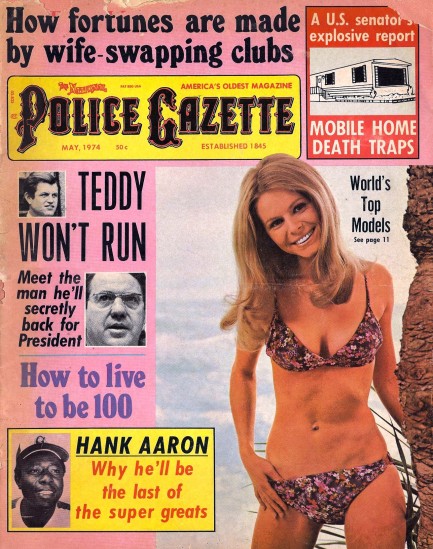
Oh, the poor National Police Gazette. By 1974 it was impossible for the editors to keep claiming Hitler was still alive and hiding out in Argentina. If he’d ever been there he was long dead. Castro was still around, of course, but it was pointless to keep pretending the U.S. was going to send an armada to take back Cuba. Mao was a useful foil for a few years, but somehow he just didn’t resonate the same way for readers. So the magazine turned its focus to pettier intrigues, dogging the Kennedy clan and hoping to move issues by featuring bikini models on its covers. How the mighty had fallen. Launched all the way back in 1845, the oldest magazine in America was now uninspired and out-of-touch with 1970s readers. In this entire issue only a few pages were even worth scanning. Teddy Kennedy, Susan Shaw, Felicity Devonshire, Sliwka… and killer catfish, all below. 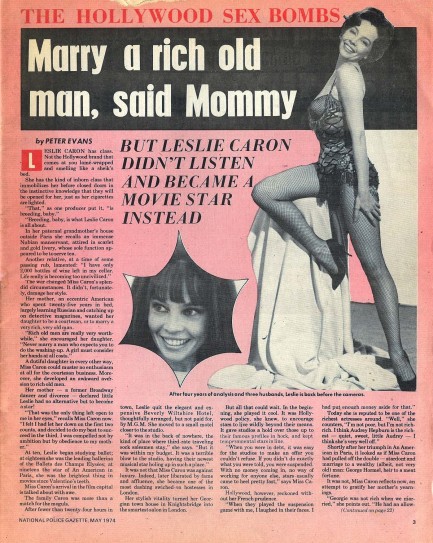 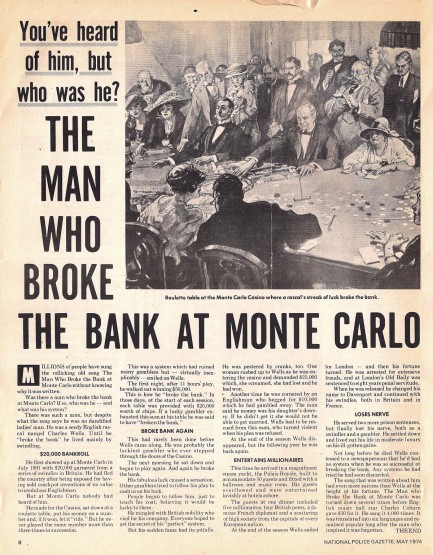 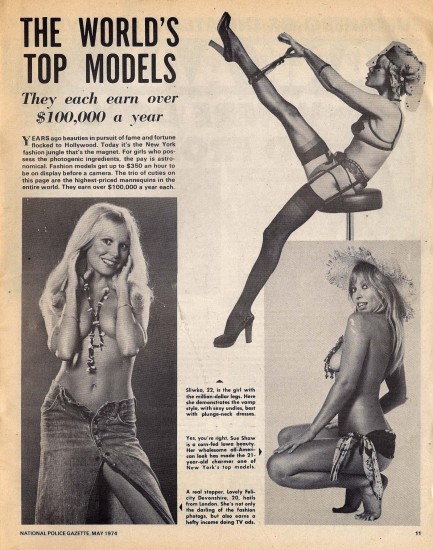  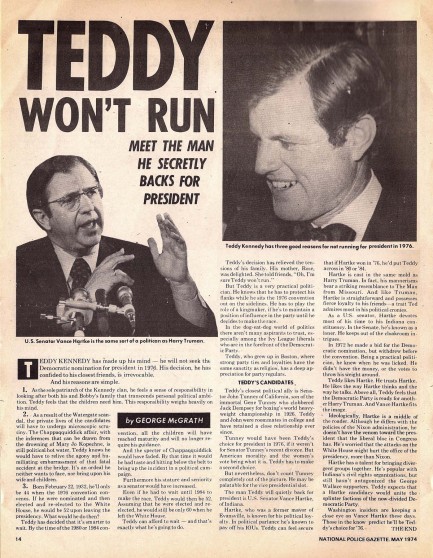 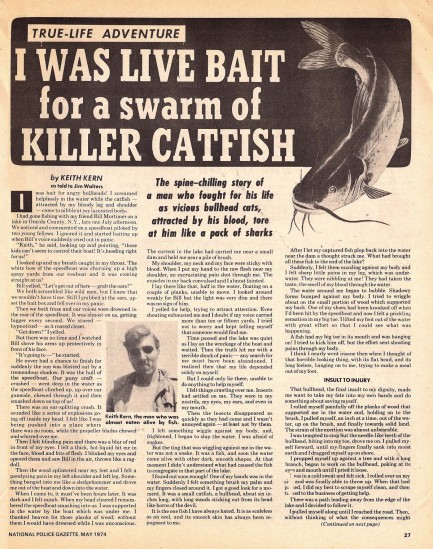
 When your wife goes to France for work you may want to consider going with her. 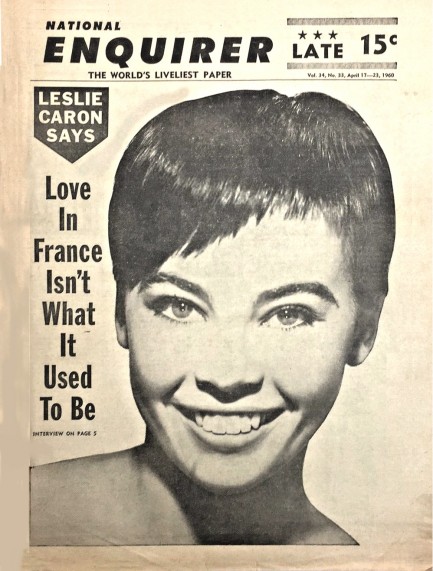
“Love in France isn’t what it used to be,” says French singer, dancer, and actress Leslie Caron. At least if National Enquirer is to be believed. This cover featuring an enchanting photo of Caron in a pixieish mode she made famous appeared today in 1960 when she was finishing work near Paris on the Napoleonic drama Austerlitz. At the time, she was having difficulties with her husband, actor Peter Hall. Caron wrote about the period in her autobiography Thank Heaven: “Temptations to have affairs were sometimes avoided, sometimes not.” In that context, this cover takes on added meaning. Would her husband have seen her words as reassuring or upsetting? In the end it didn’t matter. Filming 1961’s Fanny in Marseilles, Caron had an affair with cinematographer Jack Cardiff. So while love in France might not have been what it used to be, it was still good enough, seemingly. Caron’s subsequent whirlwind affair with Warren Beatty triggered a separation, and by 1965 she and Peter Hall divorced.
|
 |

The headlines that mattered yesteryear.
1945—Mussolini Is Arrested
Italian dictator Benito Mussolini, his mistress Clara Petacci, and fifteen supporters are arrested by Italian partisans in Dongo, Italy while attempting to escape the region in the wake of the collapse of Mussolini's fascist government. The next day, Mussolini and his mistress are both executed, along with most of the members of their group. Their bodies are then trucked to Milan where they are hung upside down on meathooks from the roof of a gas station, then spat upon and stoned until they are unrecognizable. 1933—The Gestapo Is Formed
The Geheime Staatspolizei, aka Gestapo, the official secret police force of Nazi Germany, is established. It begins under the administration of SS leader Heinrich Himmler in his position as Chief of German Police, but by 1939 is administered by the Reichssicherheitshauptamt, or Reich Main Security Office, and is a feared entity in every corner of Germany and beyond. 1937—Guernica Is Bombed
In Spain during the Spanish Civil War, the Basque town of Guernica is bombed by the German Luftwaffe, resulting in widespread destruction and casualties. The Basque government reports 1,654 people killed, while later research suggests far fewer deaths, but regardless, Guernica is viewed as an example of terror bombing and other countries learn that Nazi Germany is committed to that tactic. The bombing also becomes inspiration for Pablo Picasso, resulting in a protest painting that is not only his most famous work, but one the most important pieces of art ever produced. 1939—Batman Debuts
In Detective Comics #27, DC Comics publishes its second major superhero, Batman, who becomes one of the most popular comic book characters of all time, and then a popular camp television series starring Adam West, and lastly a multi-million dollar movie franchise starring Michael Keaton, then George Clooney, and finally Christian Bale. 1953—Crick and Watson Publish DNA Results
British scientists James D Watson and Francis Crick publish an article detailing their discovery of the existence and structure of deoxyribonucleic acid, or DNA, in Nature magazine. Their findings answer one of the oldest and most fundamental questions of biology, that of how living things reproduce themselves.
|

|
|

It's easy. We have an uploader that makes it a snap. Use it to submit your art, text, header, and subhead. Your post can be funny, serious, or anything in between, as long as it's vintage pulp. You'll get a byline and experience the fleeting pride of free authorship. We'll edit your post for typos, but the rest is up to you. Click here to give us your best shot.

|
|


 Is there such a thing as too many dots? French actress Leslie Caron tests the limits in the beachy 1965 promo photo at top. A polkadot bikini, we can all probably agree, is cute. But a polkadot bikini with a floppy polkadot hat? Is she possibly violating the dot density rule where the oh so fragile line into clown territory is crossed?
Is there such a thing as too many dots? French actress Leslie Caron tests the limits in the beachy 1965 promo photo at top. A polkadot bikini, we can all probably agree, is cute. But a polkadot bikini with a floppy polkadot hat? Is she possibly violating the dot density rule where the oh so fragile line into clown territory is crossed?














































































